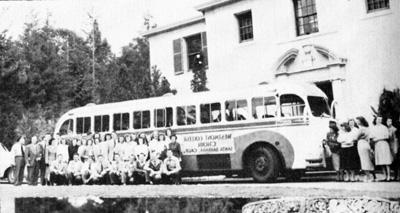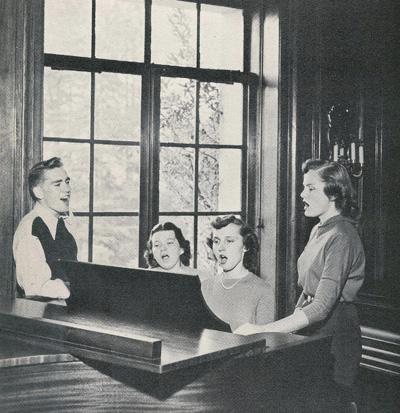历史:1950年代 用音乐说出来
第一个韦斯特蒙特合唱团像所有韦斯特蒙特合唱团一样巡回演出. But unlike its successors, this choir counted one-third of the student body as members. How did Westmont manage to field a 30-voice choir with only 94 students?
当约翰·哈伯德在20世纪40年代初听到唱诗班时, 他问导演海伦·卡瑟伍德·斯特兰德伯格这个问题. 我记得很清楚,她说, “好吧 we do a lot of praying…After I came to Westmont and saw how she worked with the choir, I realized there was a good deal of hard work and many other things that went into it besides 祈祷! 但我很欣赏这个答案.”
哈伯德对唱诗班评价很高. “学生的素质给我留下了深刻的印象, 优异的性能, 精神氛围盛行.”
John Lundberg also heard the choir that first year and shared Hubbard’s enthusiasm. “(海伦)做得很好. 她很好. 那个唱诗班给我留下了深刻的印象.”
President Emerson deliberately emphasized music during the early years of the College. 他认为这是“正常人生活中令人向往的一部分”,他知道它的公共关系价值. 音乐团体与教堂建立了关系, 招募学生, 并传播了韦斯特蒙的名字.
第一年,好几个乐团都很活跃. The trumpeters, a women’s trio, a men’s quartet, and a string quartet also performed for churches. By 1941 the College added a string trio, a mixed sextet, and a little symphony orchestra. 第二次世界大战使所有这些团体难以继续下去. But a musical tradition had already taken root, and it continued despite the war.
这个传统包括表演和分享福音. The choir stated their purpose as follows: “To provide a means whereby consecrated Christian young people with musical ability may serve the Lord Jesus through spirit-filled choral singing and personal testimony.”
John Hubbard joined the music faculty in 1944 as chair of the department. “My mandate was to try to pull together the activities of the music department…I recall Dr. Emerson saying to me, ‘We don’t care whether you actually teach any course or not’….然而, 第一年我确实教过课, and gradually…began to work my way up to practically a full-time teaching load.”
哈伯德在20世纪40年代末开始指挥唱诗班. “我继承了一个非常强大的合唱传统. 没有必要以此为基础. My problem was to maintain it at the high level of musical and spiritual quality that it had already manifested through the earliest years of the school.”
Singing in the choir gave students a chance to develop musically and spiritually. 根据哈伯德的说法, “最好的音乐是宗教音乐, 所以把这两个元素结合起来是没有困难的.唱诗班作为一个团体也在成长. “人们有着不同的背景和个性…….由于共同的原因而团结在一起, 祈祷, study of the Scriptures…and by hard work…This was one of the highest values of the choir work during those years.”
哈伯德还认为唱诗班是一种公关工具. “It was one of the best ways I knew for people to get a sampling of the type of student who came here.”
玛克辛·金凯德记得1961年在哈伯德手下唱歌. “The year 1956 will always remain in my heart and mind…Our tour was an experience never to be forgotten. 我们的音乐会有好有坏. 哈伯德告诉我们他要离开韦斯特蒙. 唱诗班同心协力,唱出了他们以前从未唱过的歌. 爱的流露通过歌声为这鼓舞人心, 美丽的人类可以被所有人感受到和听到. 拉尔夫·德拉维加在唱诗班的肩膀上拍到了他的照片. 约翰按照他的指示,每个字每个音符都照做了. 多么幸福的人和朋友啊. 他和我们分享,给了我们很多. 我感谢他所做的一切,感谢他对我们真诚的爱.” Hubbard didn’t actually leave until 1963 when he went to Manila as a musical consultant with the Far East Broadcasting Company.
In 1955, Hubbard’s wife, Ruth, became seriously ill and died a few days later. The alumni decided to build a music practice building as a memorial to her – many had known her well. 哈伯德设计了这个设施. The Ruth Gapen Hubbard Memorial Building has provided practice space for generations of Westmont musicians.
约翰·伦德伯格于1947年来到韦斯特蒙特. For his first solo in chapel, Hubbard asked him to sing an upbeat spiritual called “Shadrach.伦德伯格对此表示怀疑. “I only did it for high school assemblies…it was kind of a raucous thing…[But] it was amazing. It practically brought the house down…At the end of chapel that day they asked me to lead in 祈祷, 所以我照做了格雷西·金对某人说, “好吧, 当我听到沙得拉的时候,我对这个年轻人感到奇怪.’ But she said, ‘When I heard him pray I figured everything was all right.’”
Lundberg’s duties included teaching voice and directing the male quartet. 哈伯德离开后,他开始在韦斯特蒙特唱诗班工作. He also sang for six years with one of the best quartets of the time: the Charles E. 富勒老式复兴四重奏. This group performed every morning at 7:30 for a live radio broadcast from Hollywood. Lundberg lived in Santa Monica and commuted to Westmont two or three days a week to teach. “我差点就退学了,因为它太累人了. 但我真的感受到上帝的召唤,来到这里.”
For 22 years he worked with the Westmont quartet and arranged most of their music. 伦德伯格对四重奏的许多成员都记忆犹新, 不停地说出名字,讲述每个人的轶事. “At one point I needed a first tenor and quickly taught Dave [Hubbard], 通常是次男高音, 部分. 他花了五分钟才明白过来.
“I met John Felton when he was a baby and I was singing in the varsity quartet at the University of Washington. 四重奏中的男低音是约翰的叔叔. 约翰长大后有一副美妙的男低音.
“During the mid 1950s on a tour in the Midwest, two young men followed the quartet around. 保罗·桑德伯格, 曾为安息港传道部唱歌的人是其中之一吗, 还有保罗·肖隆德, 谁是一个非常好的作曲家和指挥家, 是另一个. 夫人. 科尔帮助他们获得了威斯蒙特大学的奖学金. 也, 彼得·格迪斯和克里斯·格迪斯在帕萨迪纳向四重奏开放了他们的家, and gave them a key to the house so they could raid the refrigerator any time.”
保罗·肖隆德回敬了他. “John Lundberg was the first all-out 专业 musician and singer I studied under. 他有资格教你任何方面的音乐, and it was a joy and a thrill to be challenged to the absolute limits every day. He was both a natural born musician from the heart and a thoroughly prepared and academically knowledgeable scholar. 这真是令人难以置信的激动. John Lundberg was the principal reason the quartet was capable of delivering a powerful, 专业, 精神上的有效表现.”
Sjolund, an internationally known composer who had published several hundred works, 他还回忆起鲁迪·阿特伍德给他的鼓励, 他那个时代最优秀的福音钢琴家, 还有约翰·哈伯德. “哈伯德让我走上了一条成为我一生事业的道路. 他在课堂上给我们布置了写一首原创圣歌的作业, 他把我的稿子寄给了一个出版商,后者接受了我的稿子出版. I am a published composer today because Hubbard took the time to invest in one student.”
这个四重奏在学年和夏季都进行了巡演. 他们每个星期天都唱歌, 早上和晚上, 5月的9到11周, 6月, 七月遍及全国. Paul Sjolund spent three years with the quartet and performed in 500 concerts in 34 states and five Canadian provinces. The men appeared on TV, in churches, at banquets, and for Billy Graham crusades. 许多学生在听了四重奏之后来到了韦斯特蒙特. 他们通常对学院的其他情况一无所知.
但四重奏在20世纪60年代末就过时了, 伦德伯格在1969年建议解散韦斯特蒙特. Three years ago, students revived this tradition, and Lundberg has been working with them.
四方, 就像唱诗班, has played a large role in recruiting students and representing both Westmont and the Gospel. 根据伦德伯格的说法, “Music is only a vehicle through which the text of the gospel is heard – the text is the whole thing.” Westmont ensembles of the 1940s and 1950s used the vehicle well, both musically and spiritually.


